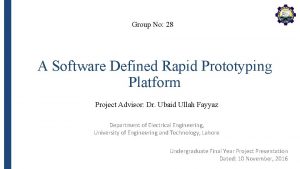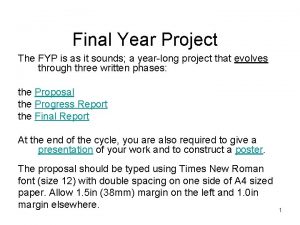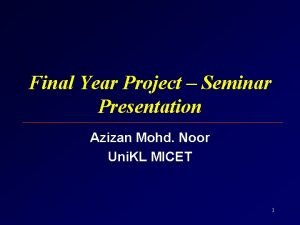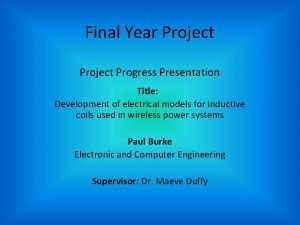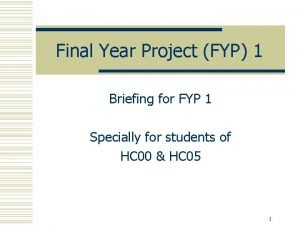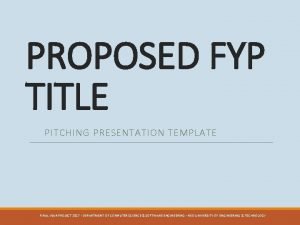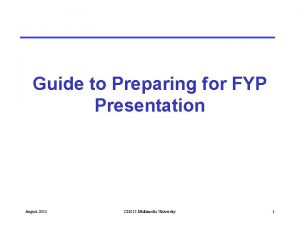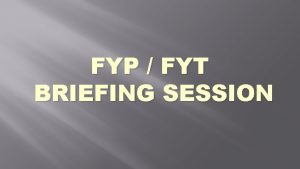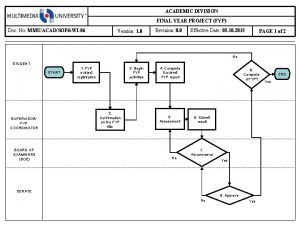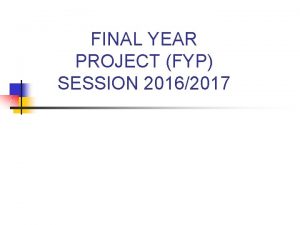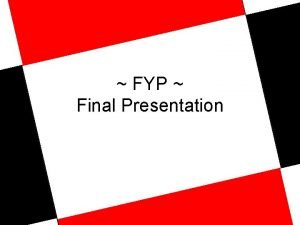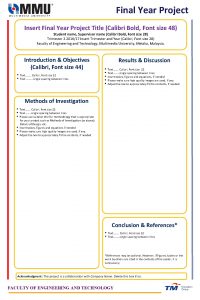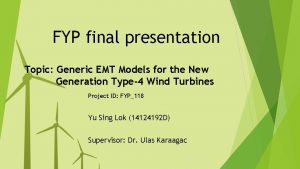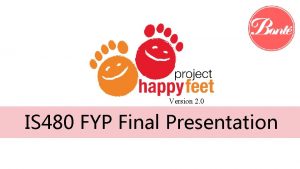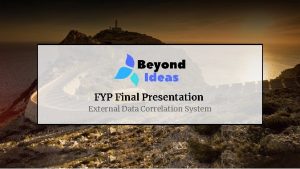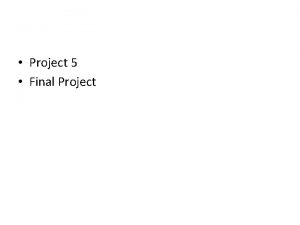Final Year Project The FYP is as it

















- Slides: 17

Final Year Project The FYP is as it sounds; a year-long project that evolves through three written phases: the Proposal the Progress Report the Final Report At the end of the cycle, you are also required to give a presentation of your work and to construct a poster. The proposal should be typed using Times New Roman font (size 12) with double spacing on one side of A 4 sized paper. Allow 1. 5 in (38 mm) margin on the left and 1. 0 in margin elsewhere. 1

• For the three written phases of the project, it is important to realize that each is derived from the phase before it. Thus, there is a lot of thinking, planning, and writing involved in putting together the Proposal. • The Progress Report evolves from the Proposal -- it should not be a completely new document. Far too many students spend an exorbitant amount of time reinventing the wheel, drafting completely new introductions for their Progress Report and their FYP. • Work smart -- put time and effort into thinking and reading about your topic at the Proposal phase. Then, when coming to the Progress Report and the FYP, break the information down into three subgroups: 2

• • information that is > 50% new information that is < 50% new information that can be recycled This will provide a logical plan regarding how your team should prioritize writing time 3

Proposal • Structure – Title Page – Table of Contents – Introduction – Methodology – Project Planning – Hardware and Software Requirements – References – Appendices 4

Title Page 5

Table of Contents 6

Introduction • • • gives the project a context explains why the project is important states what the FYP aims to accomplish and how provides objectives identifies possible problems or complications • is written for a non-specialist 7

• • Example: Gaming, as both a cultural phenomenon and a lucrative global business [why the project is important], has enjoyed enormous success over the past five years. With this increase in popularityhas come a demand for more sophisticated 3 D modeling. [context] The push in the industry is for smoother, seamless graphics. [problem] For this project, we will design a software program intended to greatly enhance the capabilities of 3 D Studio Max to produce more realistic graphics. [state what the proposal aims to accomplish and how] • Think of your objectives as what you want to accomplish and what you need to learn [software packages, algorithms] – What is your project objective? – Describe the scope of your project – Describe how you are going to achieve your objective • What are the problems that you will address and why? • What are your goals? What can you deliver? • What are the technical challenges and how do you plan to overcome these? 8

• Example: • For all its strengths, GPS has two related weaknesses: signal reception and the accuracy of local information. Overcoming these weaknesses would greatly enhance its performance, thereby stimulating a new generation in GPS technology and design [1]. We will create an algorithm that addresses the problem of local positioning [1] while. . . • In this project, we will achieve the following goals: X, Y and Z [2]. To achieve the first goal, we will review the literature on algorithm design and. . [3] The technical challenges involved in reaching this first goal are. . . [3] 9

Methodology • Begin your methodology with a clear description of what you were doing during the summer: literature survey/ feasibility study and/or a critical review. You do not need to address all the questions below, just the ones that are relevant to your project. • What is the history of your project topic? • What are experts in the field discussing that relates to your topic? • What are the trade-offs? • What is the latest research? • What is the state-of-the-art in your project area? 10

Example • • • • Design - Figure out what the sub-problems are and what approach to take or what theory to investigate. theory based conceptual Implementation - Build it tools? technical skills based Testing - How are you going to ensure that it [the program/ game/ etc. ] works correctly? [black box/ white box/ regression testing] look at the project from a micro level include experiments look at system results test each part of the system make sure that design and implementation work Evaluation - Evaluate your results relative to your stated objective: look at the project from a macro level measure performance compare your system/model with one or more (a) baseline systems/models, and/or (b) similar competing systems/models 11

Project Planning • All projects require planning including an outline of who in the team is doing what and when; thus, you will need to include a Gantt chart. • A Gantt chart is constructed with a horizontal axis representing the total time span of the project, broken down into increments (for example, days, weeks, or months) and a vertical axis representing the tasks that make up the project (for example, if the project is outfitting your computer with new software, the major tasks involved might be: conduct research, choose software, install software). Horizontal bars of varying lengths represent the sequences, timing, and time span for each task. Using the same example, you would put "conduct research" at the top of the verticle axis and draw a bar on the graph that represents the amount of time you expect to spend on the research, and then enter the other tasks below the first one and representative bars at the points in time when you expect to undertake them. The bar spans may overlap, as, for example, you may conduct research and choose software during the same time span. As the project progresses, secondary bars, arrowheads, or darkened bars may be added to indicate completed tasks, or the portions of tasks that have been completed. A vertical line is used to represent the report date. 12

13

Citations and References • Throughout the paper, you must provide citations whenever you paraphrase and/or summarize someone else's ideas and when you use a direct quote. The citation style preferred by the COMP department is the number system. • Not providing citations hurts your team and your work in several ways. First, it makes your team look like a bunch of amateurs. Second, it discredits your work. Third, providing no citations equals plagiarism-the academic equivalent to robbery. Examples of what constitutes plagiarism. 14

References • Under the Harvard System, references are made by giving the author's surname together with the year of publication. In the text, the year of publication appears within parentheses after the author's surname if the latter forms part of a sentence; for examples, Ch'ng (1986) or Saleh and Zainuddin (1987) or, where there are more than two authors, Nagendran et. al (1990). • In contrast, both the author's surname and the year of publication appear within parentheses if the author's surname does not form aprt of a sentence; for example: (Omar & Tan, 1989). 15

• At the end of thesis, all the references cited are listed in alphabetical order. • There is no necessity to number the references. References to periodicals should be listed as follows: • aauthors' surnames and initials (instead of first author et. al), year of publication in parentheses, exact title of paper, contracted title of periodical in italics (or underlined), volume number in Arabic figures double underline (or in bold print), initial and final page numbers of article. For example: • Kalotas, T. M. & Lee, A. R. (1990). A simple device to illustrate angular momentum conservation and instability. Am. J. Phys. 58(1), 80 -81. 16

• In the Harvard System, the titles of books are in italics followed by the town and publisher. For example: • Conn, E. E. , Stumpf, P. K. , Bruening, G. & Doi, R. H. (1987). Outlines of. Biochemistry, 3 th edn. New York: John Wiley & Sons. • Reference from an edited book may be written thus: • Hocking, A. D. (1988). Moulds and yeasts associated with foods of reduced water activity: ecological interactions. In Food Preservation by Moisture Control (Seow, C. C. , ed. ), p. 57 -72. London: Elsevier Applied Sci. Publ. 17
 Conclusion for final year project
Conclusion for final year project Gantt chart for final year project
Gantt chart for final year project Fyp introduction example
Fyp introduction example Project seminar presentation
Project seminar presentation Engineering final year project presentation sample
Engineering final year project presentation sample Utar final year project
Utar final year project Acknowledgement for b tech final year project
Acknowledgement for b tech final year project Class project f4
Class project f4 Fyp presentation template
Fyp presentation template Brian finan
Brian finan Augmented reality final year projects
Augmented reality final year projects Year 6 leaver poems
Year 6 leaver poems Lkc lab
Lkc lab Fyp presentation slides example
Fyp presentation slides example Sample conclusion in thesis
Sample conclusion in thesis Ust fyp
Ust fyp Fyp methodology example
Fyp methodology example Fyp weebly
Fyp weebly

